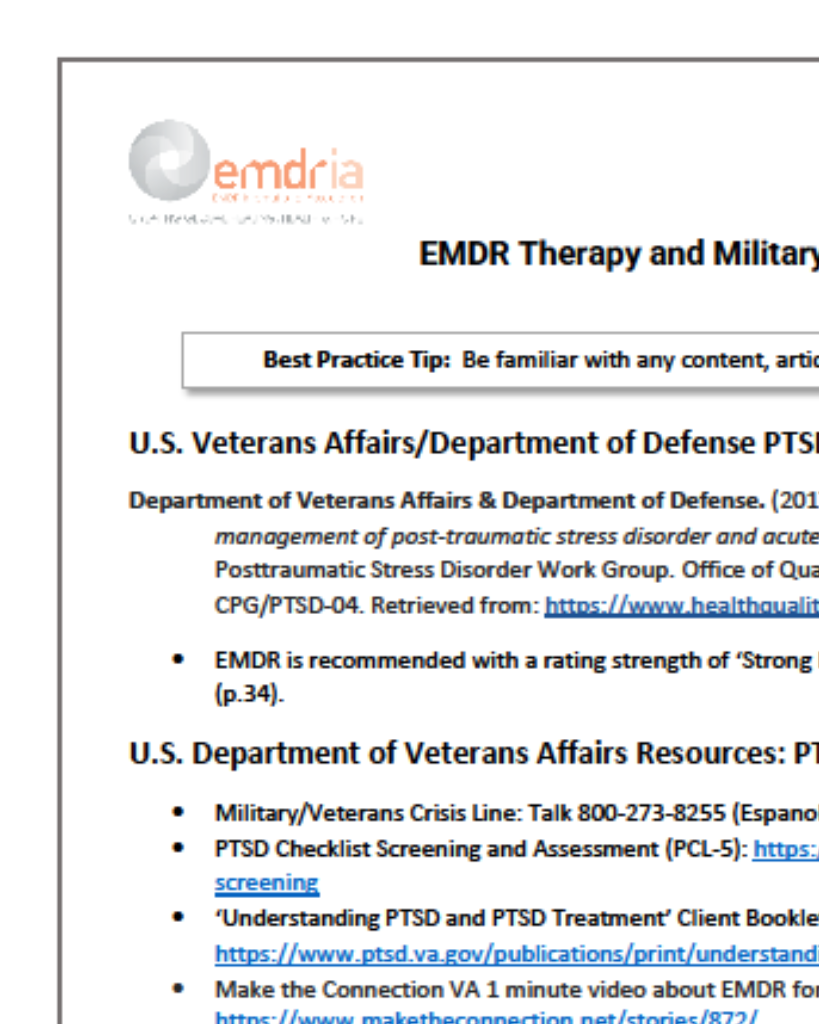Predicting outcome in an intensive outpatient PTSD treatment program using daily measures
This study aims to determine the predictive value of treatment response on treatment outcome in intensive treatment programs in which patients receive three hours of trauma therapy (prolonged exposure and EMDR) as well as physical activity and psychoeduction.
Article Abstract
“It is useful to investigate factors that could predict treatment outcomes for PTSD. The current study aims to investigate the relationship between daily measured PTSD symptoms during an intensive six-day treatment program and overall post-treatment outcomes. The treatment program combines eye movement desensitization with reprocessing and prolonged exposure, as well as physical activity and psychoeducation. It was expected that for the entire duration of treatment, as well as the first half of the treatment, a greater decline in daily PTSD symptoms would be a predictor for a greater decline in PTSD symptoms at a four-week follow-up. Data from 109 PTSD-patients (87.2% female, mean age = 36.9, SD = 11.5) were used. PTSD symptoms were measured with the CAPS-5 and the self-reported PTSD checklist for DSM-5 (PCL-5). Daily PTSD symptoms were measured with an abbreviated version of the PCL-5 (8-item PCL). Latent growth curve models were used to describe changes in daily PTSD symptoms and predict treatment outcome. Results show that a greater decline in daily PTSD symptoms measured by the 8-item PCL predicts better treatment outcome (CAPS-5 and PCL-5), but that a patient’s PTSD symptoms on the first day of treatment has no predictive effect. A decline in PTSD symptoms only during the first half of treatment was also found to predict treatment outcomes. Future research should be focused on replicating the results of the current study.
The current study aims to determine the predictive value of treatment response on treatment outcome in such an intensive treatment program, which consists of two weeks of treatment for three consecutive days each. Patients receive three hours of trauma therapy (PE and EMDR), one hour of physical activity and one hour of psychoeducation every day. The results of a meta-analysis showed that adding physical activity to usual care improved the health of PTSD patients and was effective in decreasing PTSD symptoms [31]. A combination of PE, EMDR, physical activity and psychoeducation in an inpatient intensive treatment program was found to be effective in reducing PTSD symptoms.”
—Description from publisher
Article Access
Open Access
Alting van Geusau, V. V. P., Mulder, J. D., & Matthijssen, S. J. M. A. (2021). Predicting outcome in an intensive outpatient PTSD treatment program using daily measures. Journal of Clinical Medicine, 10(18), 4152. Open access: https://doi.org/10.3390/jcm10184152
Date
September 15, 2021
Creator(s)
Valentijn V. P. Alting van Geusau, Jeroen D. Mulder, Suzy J. M. A. Matthijssen
Topics
PTSD
Practice & Methods
Integrative Therapies, Intensives
Extent
12 pages
Publisher
MDPI
Rights
Copyright: © 2021 by the authors. Licensee MDPI, Basel, Switzerland. This article is an open access article distributed under the terms and conditions of the Creative Commons Attribution (CC BY) license (https://creativecommons.org/licenses/by/4.0/).
APA Citation
Alting van Geusau, V. V. P., Mulder, J. D., & Matthijssen, S. J. M. A. (2021). Predicting outcome in an intensive outpatient PTSD treatment program using daily measures. Journal of Clinical Medicine, 10(18), 4152. Open access: https://doi.org/10.3390/jcm10184152
Audience
EMDR Therapists, Other Mental Health Professionals
Language
English
Content Type
Article, Peer-Reviewed
Access Type
External Resource, Open Access





